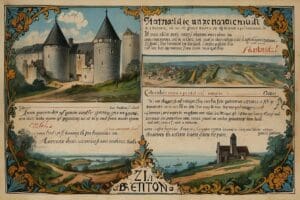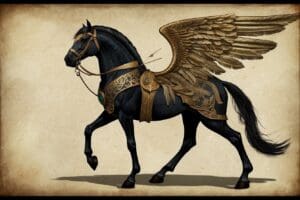The Bedouin Trails: Unveiling the Secrets of Desert Nomads and their Caravans
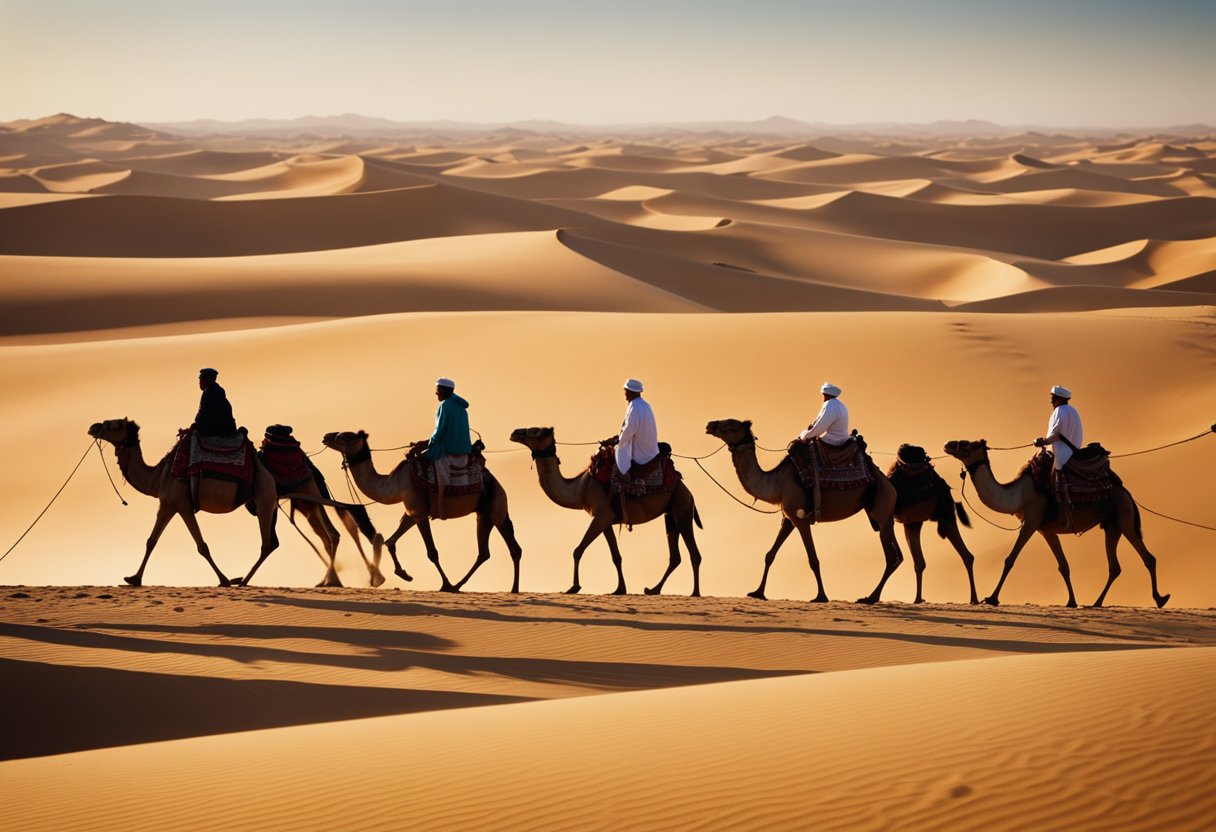
Updated On: April 17, 2024 by Yomna Salah
Venturing through the sands of time, we trace the enduring legacy of the Bedouin people, whose lives have been interwoven with the undulating dunes of the desert. The Bedouin trails, synonymous with survival and adaptability, have long been the lifelines across seemingly endless arid expanses. Central to these trails is the camel, an animal so essential to the Bedouin way of life that it is dubbed the ‘ship of the desert’, adept at managing long distances under harsh conditions with little sustenance.
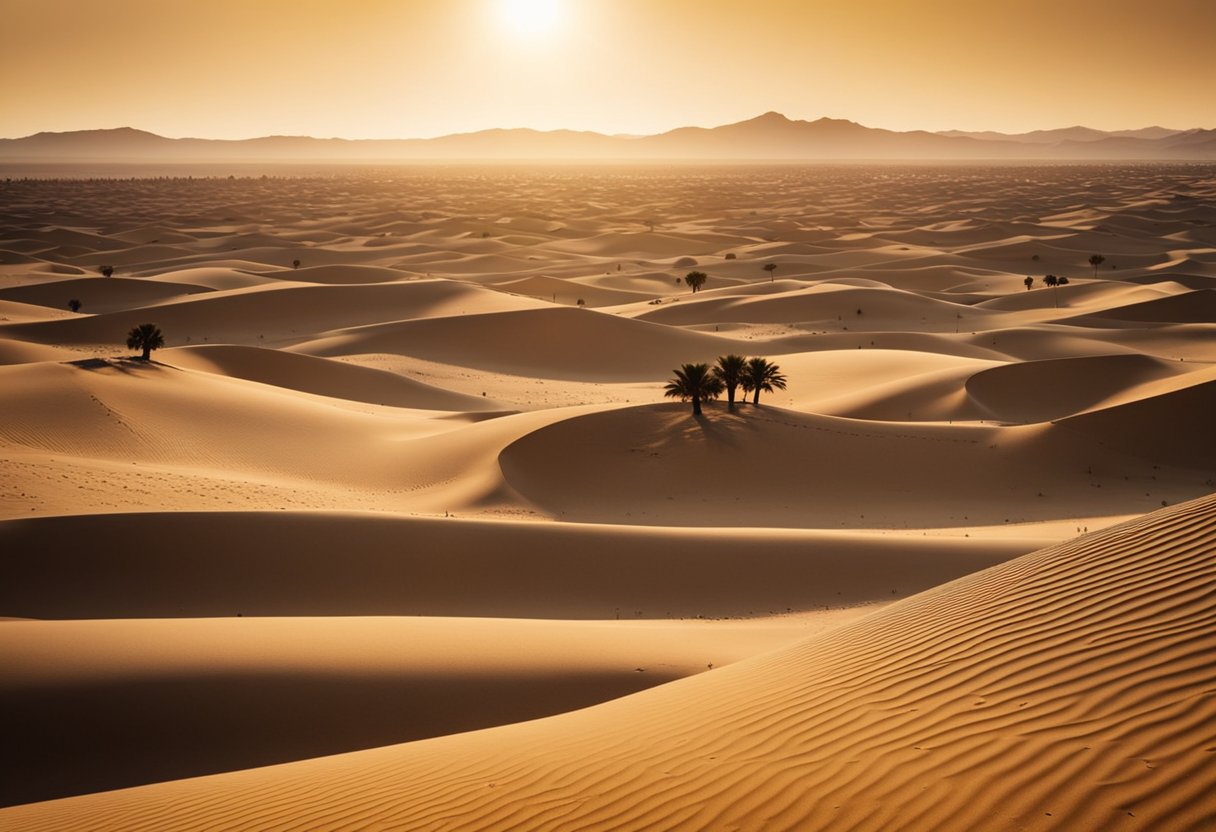
Historically, the Bedouins utilised detailed knowledge of the stars and land to navigate the vast, challenging terrain of the desert. Traditionally, the survival of Bedouin tribes centred upon a nomadic lifestyle, their culture and economy deeply rooted in the trade and caravans that coursed through the Sahara and Arabian deserts. This intricate network of routes facilitated not only commerce but also a cultural exchange that shaped the history and societies across North Africa and the Middle East.
Today, we stand witness to a rich tapestry of Bedouin culture, which, while persisting against the backdrop of modern adaptation, has maintained the essence of its heritage. From the traditional tents that characterize their domestic life to the artistic and spiritual expressions that define their identity, the Bedouin impact is profound. As custodians of such a vital part of human history, they continue to interact with wider society, serving as a bridge between the past and present.
Table of Contents
Bedouin Trails: Origins and Culture
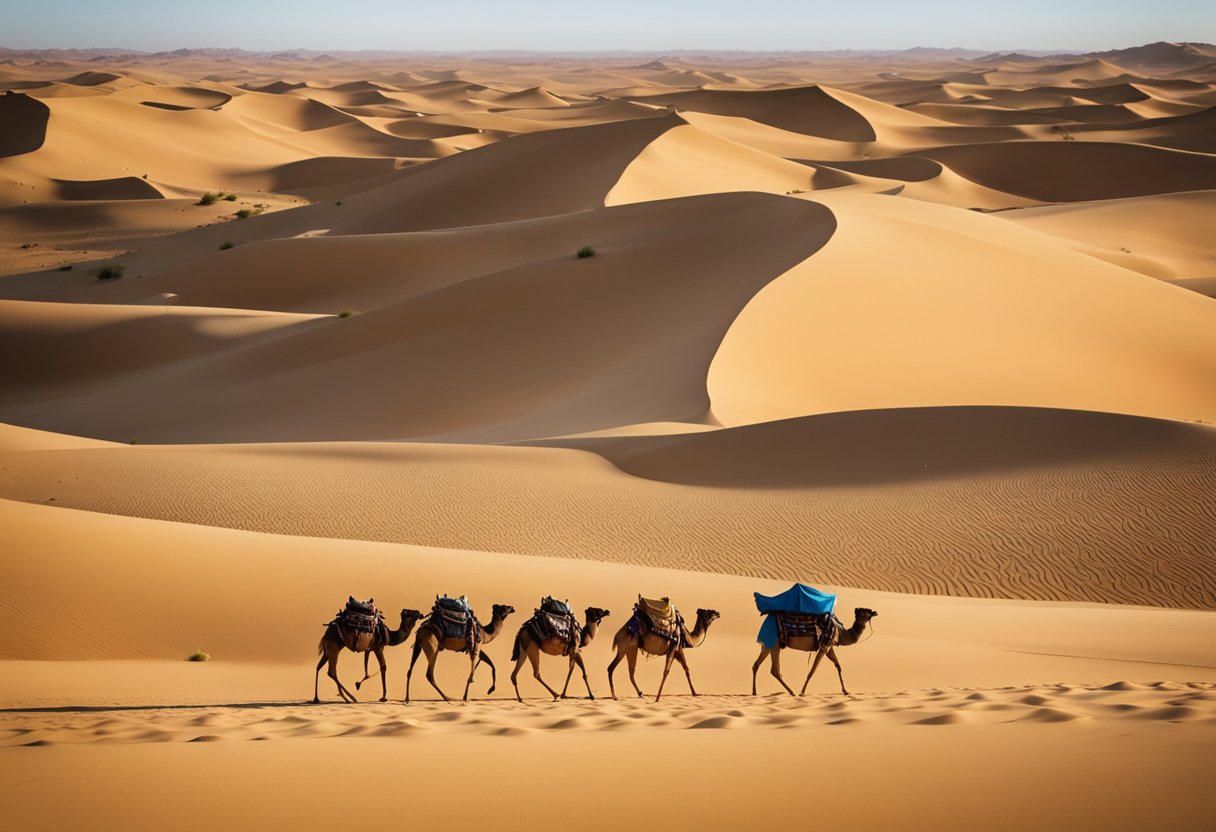
The Bedouin people embody a rich cultural heritage and a nomadic way of life deeply rooted in the deserts of the Middle Eastern lands. They have established a variety of traditions and social structures that have been perpetuated through the generations.
Tribal Structure and Nomadic Lifestyle
The very essence of Bedouin identity is encapsulated within their tribal structure and nomadic lifestyle. Historically, Bedouin tribes are flexible entities, often formed by lineage but also through alliances and marriage. Their nomadic movements are intricately tied to the seasons, with migrations into the desert during the rainy winter months and returning to cultivated lands when it’s dry.
Families within the tribe are connected by a profound sense of social cohesion and mutual assistance. This is showcased through their nomadic practices, where they travel in groups known as goums. These goums serve as the basic units of Bedouin tribal life, functioning as self-sustained entities within the larger tribal community.
Cultural Practices and Social Norms
Bedouin culture and customs are deeply ingrained in their everyday life, with oral traditions, such as poetry, playing a central role. Their poetry is not just a form of artistic expression but also a means of communication and conserving their cultural heritage.
Social norms among the Bedouins are characterized by their hospitality and strong honour code. Guests are treated with the utmost respect and are offered protection and sustenance, reflecting deeply held Bedouin customs. Furthermore, their traditional practices, such as marriage ceremonies, though evolving, continue to be significant in maintaining their cultural identity.
Language, particularly Arabic, is significant in Bedouin society. It is not just a means of communication; it is also a repository of culture, encapsulating its identity, history, and values within its lexicon and idioms.
Ours is a deep dive into the continuous tapestry of Bedouin life, where the threads of history, language, and tradition intertwine to create a vibrant cultural landscape reflective of their resilience and adaptability in the face of ever-changing environments.
The Bedouin and Their Camels

We observe that the relationship between the Bedouins and their camels is one deeply interwoven with tradition, necessity, and respect.
Camel Breeding and Husbandry
Camel breeding is a skilled practice among the Bedouin, where the intricacies of lineage and characteristics are well understood. Our understanding is that the Bedouin prefer camels that can endure the harsh desert conditions, particularly dromedaries, known for their single hump and resilience. Bactrian camels, with two humps, are less common but also present in certain regions. The breeding process is meticulous, with attention to producing camels for various uses, including carrying loads, producing milk, and meat.
Camel husbandry is similarly methodical: a camel herd is managed to maintain the animals’ health and the quality of milk production. The milk of camels is not only a dietary staple but also has cultural significance to the Bedouin, and thus, camels are tended with great care to ensure sufficient milk yield.
The Camel in Bedouin Society
In Bedouin society, the camel holds a place of honour and is often referred to as the ‘ship of the desert’. This nomenclature reflects the animal’s essential role in providing transportation across the vast and challenging desert landscapes. It has facilitated the nomadic lifestyle of the Bedouin, aiding in long travels for trade, and has provided a means for the Bedouin to adapt to the extremes of their environment.
Additionally, camels serve cultural functions, being central to Bedouin folklore, poetry, and art. The bond between the Bedouins and their camels transcends mere utility. It is a familial relationship that is nurtured from birth, with camels often considered part of one’s extended family. This cultural interdependence between the Bedouin and the camel fortifies their identity and their ability to thrive in the desert’s unforgiving terrain.
Desert Survival and Navigation
In the vast and often unforgiving desert landscape, the ability to source water and navigate effectively can mean the difference between life and death. We turn to age-old wisdom and time-tested techniques that have enabled survival in these harsh conditions.
Water Sourcing and Conservation
Finding water in the desert is a critical skill. Ancient desert dwellers would often locate hidden water sources like hidden springs or aquifers. To conserve this precious resource, they practised methods such as drinking sparingly and using water from moist vegetation. Additionally, travel was sometimes aligned with the presence of known watering places, which acted as lifelines for both humans and animals alike.
- Look for animal tracks: They can lead to water sources.
- Observe vegetation: Types such as the desert squill can indicate water nearby.
- Conserve sweat, not water: Drink when thirsty but minimise physical exertion.
Traditional Navigation Techniques
Navigation without modern equipment relies heavily on environmental cues and celestial bodies. The Bedouins, for instance, have mastered the art of using the stars, sun, and wind to guide their travels across the desert. They also utilised their intimate knowledge of the landscape, such as recognising rock formations and dune patterns, to navigate the seas of sand.
- Stars: Use constellations like Ursa Major to find direction.
- Sun: Shadow stick method to determine cardinal points.
- Landmarks: Recognise and remember specific terrain features for orientation.
The Role of Tents and Domestic Life
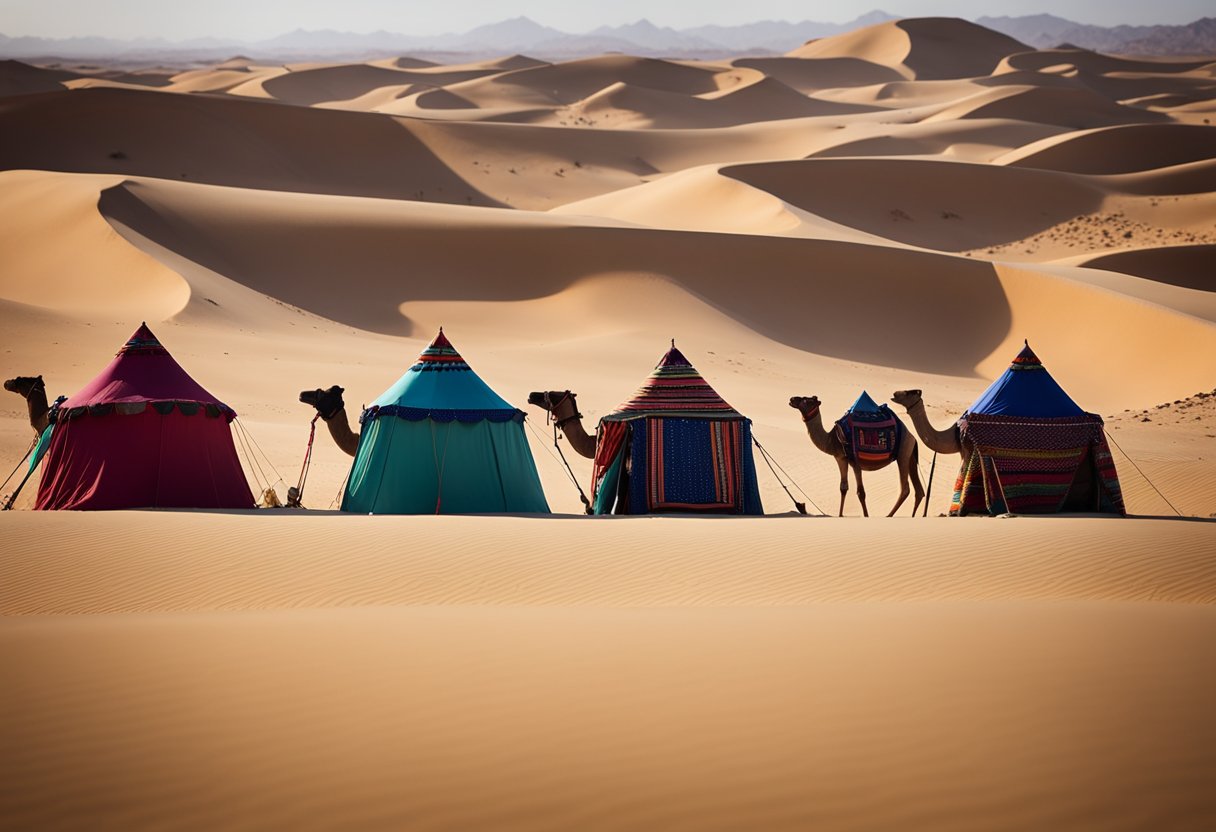
In this section, we explore the significance of tents as a cornerstone of Bedouin domestic life and the rich family traditions within.
Tent Architecture and Function
Tents serve as the primary residence for Bedouin families, crafted meticulously to suit the harsh desert environment. The architecture of a Bedouin tent is elegantly simple, and designed for easy assembly and disassembly. The structure is typically made from goat or camel hair, known as ‘black tents’ due to their colour, which provides insulation and withstands the desert climate. The spacious interior is divided by woven partitions for privacy and designated areas for men and women. Proper ventilation is ensured through cleverly placed openings, balancing the need for airflow and shelter from sandstorms. The importance of the tent’s fungible space is seen in its ability to be both a home and a social gathering place.
Family and Daily Life
The familial unit is the bedrock of Bedouin society, centred around the safe haven of their tents. Our daily lives are steeped in tradition, where women hold prominent roles in managing the household, preparing food, and raising children. They weave the fabric of the tents, passing these skills down through generations. The tent is a hub for socialising, with separate areas designated for hosting guests distinct from the family’s private space. Children grow up learning from a young age the skills necessary to thrive in the desert, including caring for animals and understanding the nuances of their nomadic lifestyle. The cooperative nature of our domestic life ensures the continuity of our culture and the sustainability of desert living.
Trade and Economy on the Sands
As we explore the vast stretches of desert that once bustled with trade and economic activity, our focus narrows on the historic trade routes and the goods that traversed these arid expanses.
Historical Trade Routes
The desert sands whispered tales of caravans that wound like serpents across the untamed wilderness, connecting distant lands and cultures. The lifeblood of such trade lay in the well-established routes, with the Trans-Saharan trade being paramount. Linking the Sub-Saharan regions to the Mediterranean and beyond, it enabled the exchange of precious commodities such as gold, salt, and ivory. Moreover, networks akin to the famed Silk Road facilitated the movement of spices, precious metals, and silks bound for markets that spanned from China to the heart of Europe.
Goods and Commerce
It was on the backs of camels that goods such as spices, silk, and precious metals found their way across the hostile desert terrain. These caravans, often comprising hundreds of these hardy creatures, were central to commerce, moving items as diverse as gold and salt, staples that forged empires and facilitated the exchange of not just commodities but ideas and culture. Merchants and traders, risk-takers and adventurers, they all gathered to form a unique economy that thrived on the sands, binding distant worlds through the exchange of valuable and exotic merchandise.
Artistic Expression and Bedouin Heritage
In the evocative expanse of the desert, the Bedouins have long cultivated a rich tapestry of artistic expression that encapsulates their heritage. Their art is interwoven with the rhythms of desert life, echoing the values and traditions of their culture.
Music and Poetry
Music and poetry are the heartbeat of Bedouin tradition, vital to the communal and emotional landscape of these desert dwellers. The ancient practice of Al-Taghrooda involves the chanting of poetry, a moving art form that bonds the camel caravans and honours their tireless journey across the sand. Composed and recited by men, these short, improvised lines stimulate both the animals and the riders, creating a shared rhythm that propels them forward. Often, this form of poetry is less than seven lines, carrying within its verses the essence of Bedouin ethos, encapsulating their deep attachment to the desert.
Crafts and Textiles
In addition to their oral arts, the Bedouins are renowned for their intricate crafts and textiles, borne of necessity and transformed into cultural artefacts. Utilising materials readily available in their environment, they expertly fashion items essential for desert survival. Camel hair and wool are woven into their iconic tapestries, rugs and clothing, each stitch a testament to their resourcefulness and connection to the earth. Bedouin crafts are not only practical but also bear distinct patterns that reflect their identity and heritage. These items are cherished, both as practical tools and as carriers of their storied past.
Spiritual Beliefs and Islamic Influence
In the vast stretches of the desert, the spiritual lives of the Bedouins are deeply intertwined with the teachings of Islam, which shapes their cultural practices and annual celebrations.
Religion and Bedouin Life
The Bedouins, with their nomadic heritage, have embraced Islam as a cornerstone of their existence, weaving religious practices into the tapestry of their daily lives. The religion’s tenets offer guidance and structure, from the five daily prayers that rhythmically punctuate their day to the social and legal codes that govern their interactions. Respecting the Islamic principles, Bedouin customs and traditions are often a reflection of their profound faith.
Bedouins have historically played a pivotal role in the spread of Islam, with their early conversion and participation in key Islamic events further solidifying their place within the Muslim world. Their way of life has been influenced by the Islamic emphasis on hospitality and generosity, qualities that are revered in the harsh desert environment. The teachings of Islam are passed down through generations, continually reaffirming the Bedouins’ spiritual identity and ensuring the preservation of their cultural heritage.
Islamic Events and Festivals
Among the annual Islamic festivals, two of the most significant celebrations for the Bedouins are Eid al-Fitr and Eid al-Adha. Eid al-Fitr, marking the end of Ramadan, the holy month of fasting, is a time of joyous feasting and communal prayers. Bedouins gather with family and friends, sharing meals and enjoying the festive atmosphere that permeates the desert air.
Eid al-Adha commemorates Ibrahim (Abraham) ‘s willingness to sacrifice his son as an act of obedience to God. On this occasion, Bedouins partake in the ritual of sacrificing an animal, usually a sheep or a goat, and distributing the meat amongst family, neighbours, and the needy, echoing the festival’s themes of sacrifice, charity, and community. These festivals not only reinforce the Islamic faith but also underscore the Bedouin’s strong sense of community and deep-rooted cultural traditions.
Modern Transition and Cultural Adaptation
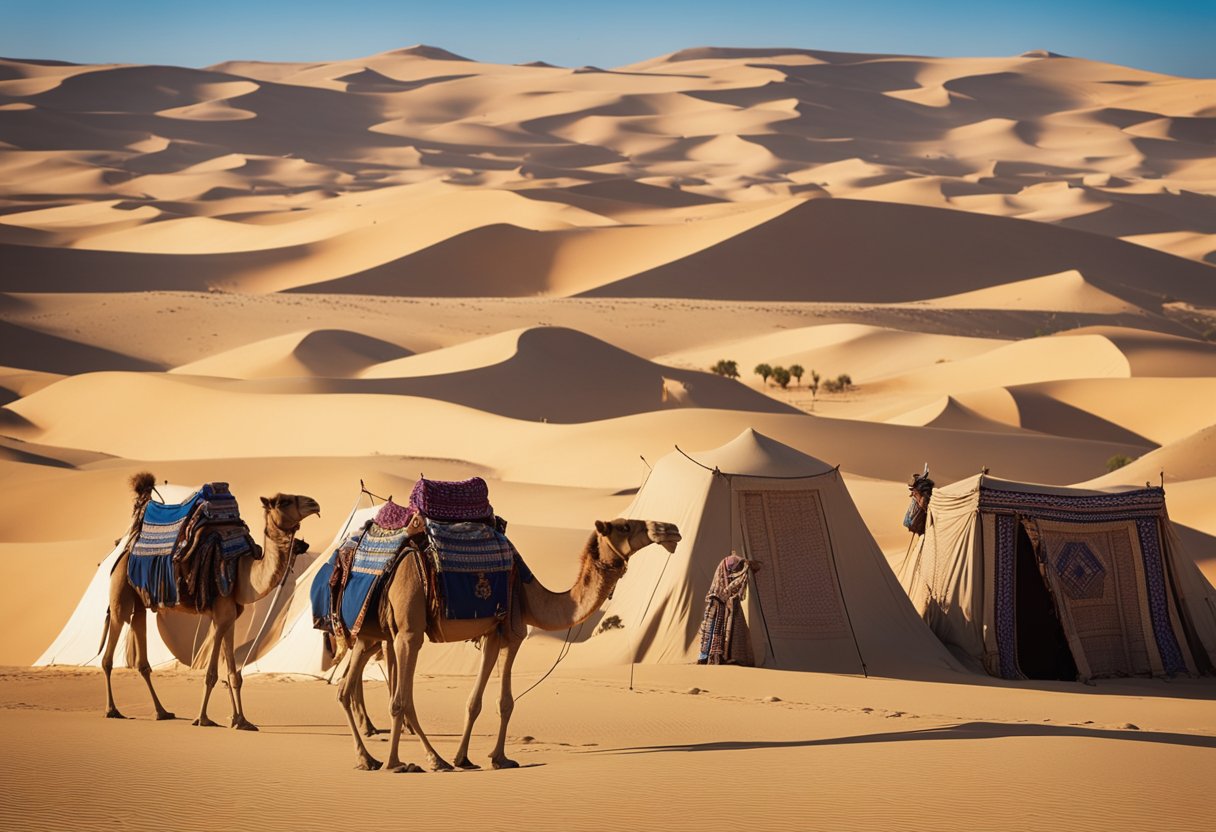
As we explore the Bedouins’ transformation in the contemporary era, we witness a striking balance between the embrace of modern conveniences and the steadfast preservation of their rich cultural heritage.
Challenges of Modernity
The Bedouin tribes have encountered a profound shift from their traditional nomadic lifestyle to a more settled existence. This has predominantly been driven by the adoption of modern transportation, where the camels, once central to their survival and known as the ‘ships of the desert’, have largely been replaced by motor vehicles for practicality and speed. For example, research indicates that Bedouins increasingly favour vehicles like the Toyota, Datsun, Nissan or General Motors pick-up over the traditional camel. This adoption has altered aspects of their socio-economic conditions, presenting new challenges, such as maintaining their cultural identity in the face of rapid modernization.
Preservation of Traditions
Despite these challenges, the Bedouins are actively engaged in preserving their cultural legacy. Fundamental to this is the transmission of oral histories and desert lore—elements that remain deeply entwined with their identity. By safeguarding customs like camel riding, which is historically embedded within Bedouin culture, they uphold a connection to their past. Although modern life has undeniably made its mark, the enduring significance of their traditions can still be felt. The Bedouins’ cultural resilience is a testament to the strength and adaptability of their communities, ensuring that the essence of their way of life continues for future generations.
Bedouin Interaction with Wider Society
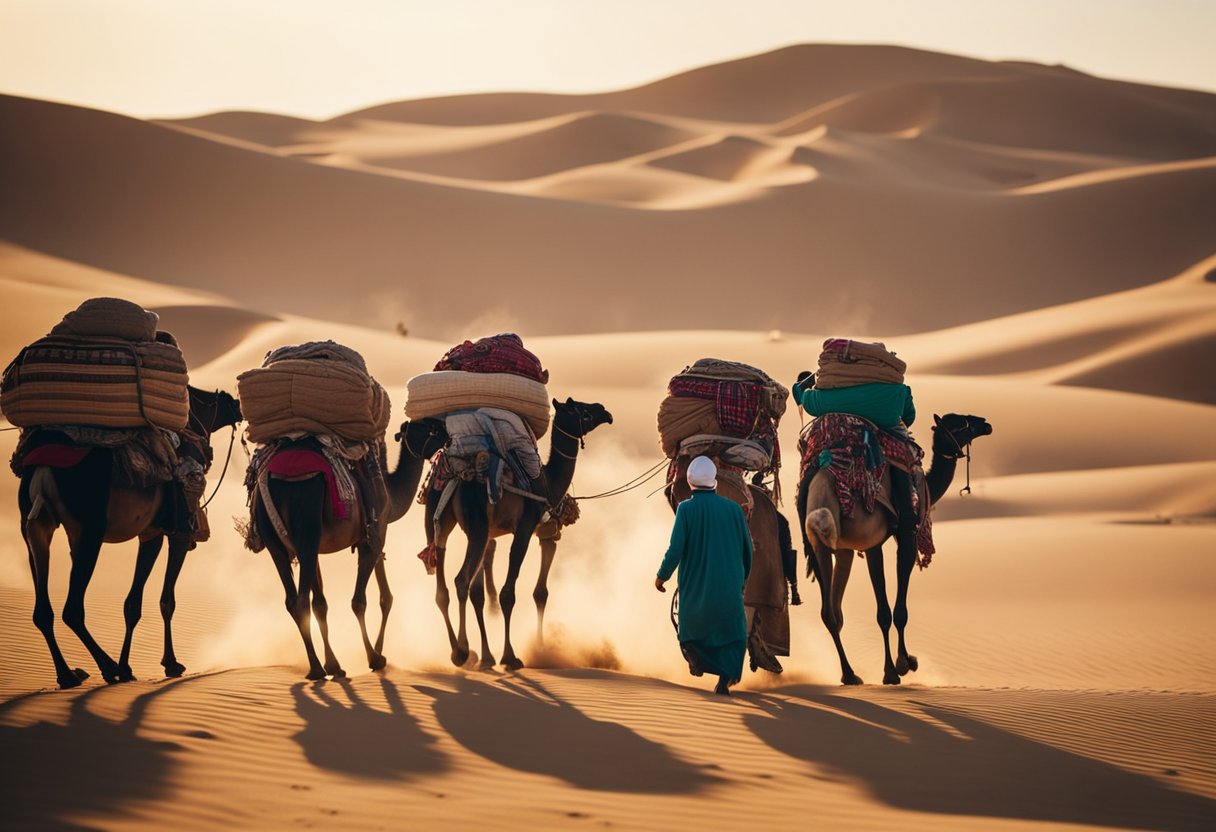
We offer an intimate glimpse into the significant role Bedouin tribes have played in shaping the social and economic landscapes of the Middle East and North Africa. Our discerning exploration reveals the nuances of their interactions through trade and conflict, which have left an indelible mark on the region.
Trade and Cultural Exchanges
Bedouins historically were essential for trade across the desert terrains of North Africa, Egypt, Sudan, and beyond. Their intimate knowledge of the land and ability to navigate vast expanses made them ideal for transporting goods and facilitating trade routes. To understand the scope of Bedouin’s influence in trade, it’s imperative to note their contribution to the spread of goods, culture, and ideas across previously inaccessible areas.
- Goods: Primarily, they transported spices, silk, and other commodities between remote areas.
- Routes: Key trading paths, including the Incense Route, were heavily travelled by Bedouins.
- Cultural Exchange: Through their interactions, Bedouins were conduits of culture, bringing together diverse peoples and customs.
These exchanges weren’t limited to commodities but extended to cultural and social interactions as well, enriching the woven tapestry of Middle Eastern societies.
Bedouin Conflicts and Alliances
Our insight extends to the complex realm of Bedouin conflicts and alliances, critical components in their historical and contemporary societal interactions. Bedouin tribes, known for their valour and strategic prowess, often clashed over resources or formed alliances that shifted regional power dynamics.
- Tribal Conflicts: Disputes over water wells or grazing rights were commonplace.
- Alliances: Political alliances, sometimes influenced by marriage, bolstered the tribe’s strength and security.
- Influence on Borders: The Bedouin’s territorial knowledge and alliances impacted the formation of national boundaries within regions such as Syria, Jordan, and others.
Through such engagements, Bedouins have been key players in the stability and shifts experienced across the vast landscapes in which they traverse.
Famous Bedouin Trade Routes
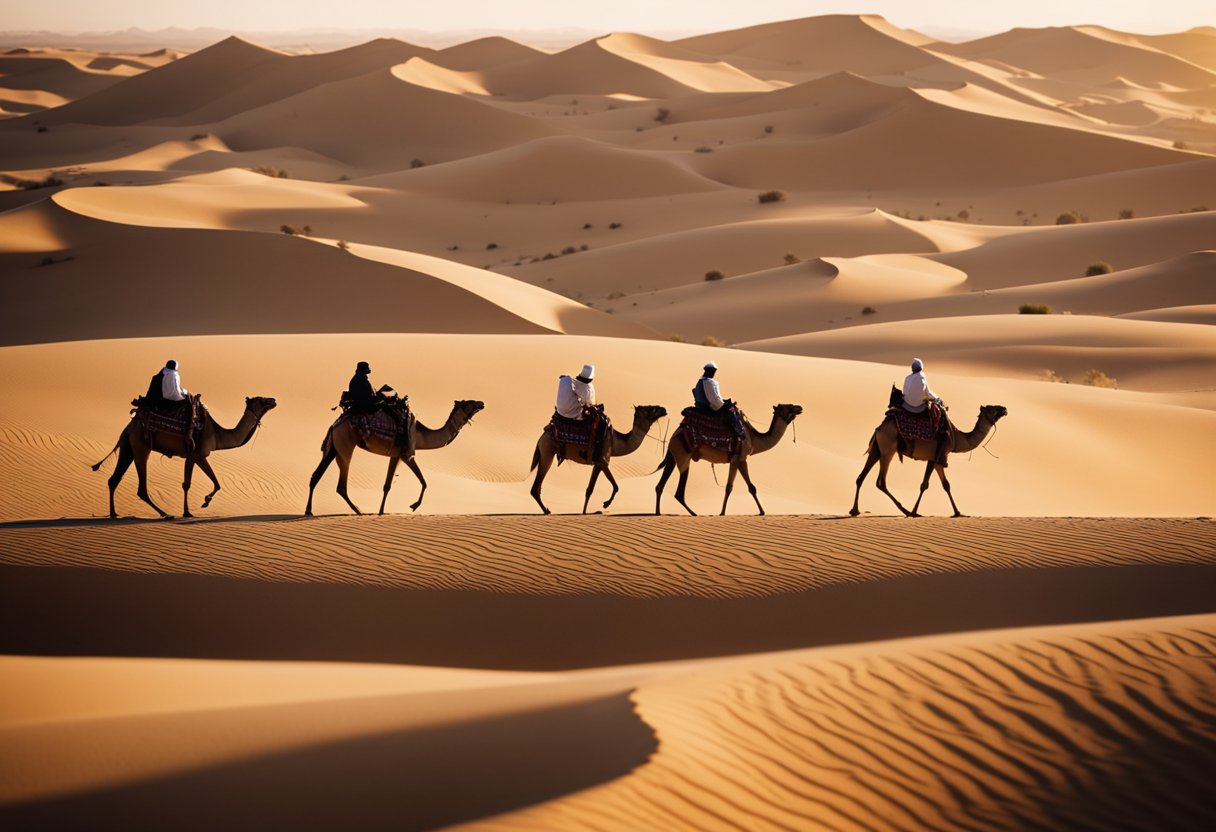
Bedouin culture intricately entwines with the historical trade routes that crisscrossed harsh deserts. We’ll explore the central avenues of commerce that not only contributed to the Silk Road but also forged vital connections across the Sahara.
Silk Road Contributions
Bedouins played a critical role in the Silk Road, a network of trade routes connecting the East with the Middle East and further into Europe. These routes facilitated the trade of not only silk but also spices, precious metals, and other valuable goods. The Bedouins, with their extensive knowledge of the desert landscape, were instrumental in guiding caravans across the Middle East section of this extensive network.
Trans-Saharan Connections
Key to the Trans-Saharan Trade was the enduring camel caravans that linked sub-Saharan Africa to the Mediterranean and beyond. Centres like Timbuktu blossomed into hubs of trade and scholarship due to these routes. The enduring relationship between camels and Bedouins was vital for navigating the Sahara and enabling trade and cultural exchanges between North Africa and the Middle East.
Bedouins in Literature and Media
Bedouins have long fascinated storytellers and audiences alike, with their unique culture often depicted in various forms of literature and media. This portrayal has significantly contributed to the wider world’s understanding of Bedouin culture.
In literature, Bedouins are frequently characterised as nomadic desert dwellers with a wealth of traditional knowledge and survival skills. Their stories, embracing themes such as hospitality and honour, are captured in many travelogues and novels. For example, the seminal work “The Bedouins and the Desert,” as found at the State University of New York Press, provides an in-depth look at this culture through a blend of personal experiences and scholarly research.
On the screen, films and documentaries have offered visual narratives of the Bedouins’ way of life, revealing both its hardships and its beauty. These media pieces often highlight Bedouin’s connections with nature, especially their adeptness in navigation and camel rearing.
| Media Type | Description |
|---|---|
| Literature | Books and travelogues detailing Bedouin life. |
| Film | Documentaries and movies portraying their culture and environment. |
Bedouin culture’s media representation serves as a testament to its cultural significance, as well as to the resilience and adaptability of its people. It introduces audiences to a way of life that is deeply rooted in the past yet continues to evolve in the modern world. Through these accounts, we gain a window into a profound and often misunderstood heritage, fostering appreciation and respect for the Bedouin traditions that have stood the test of time.
Frequently Asked Questions
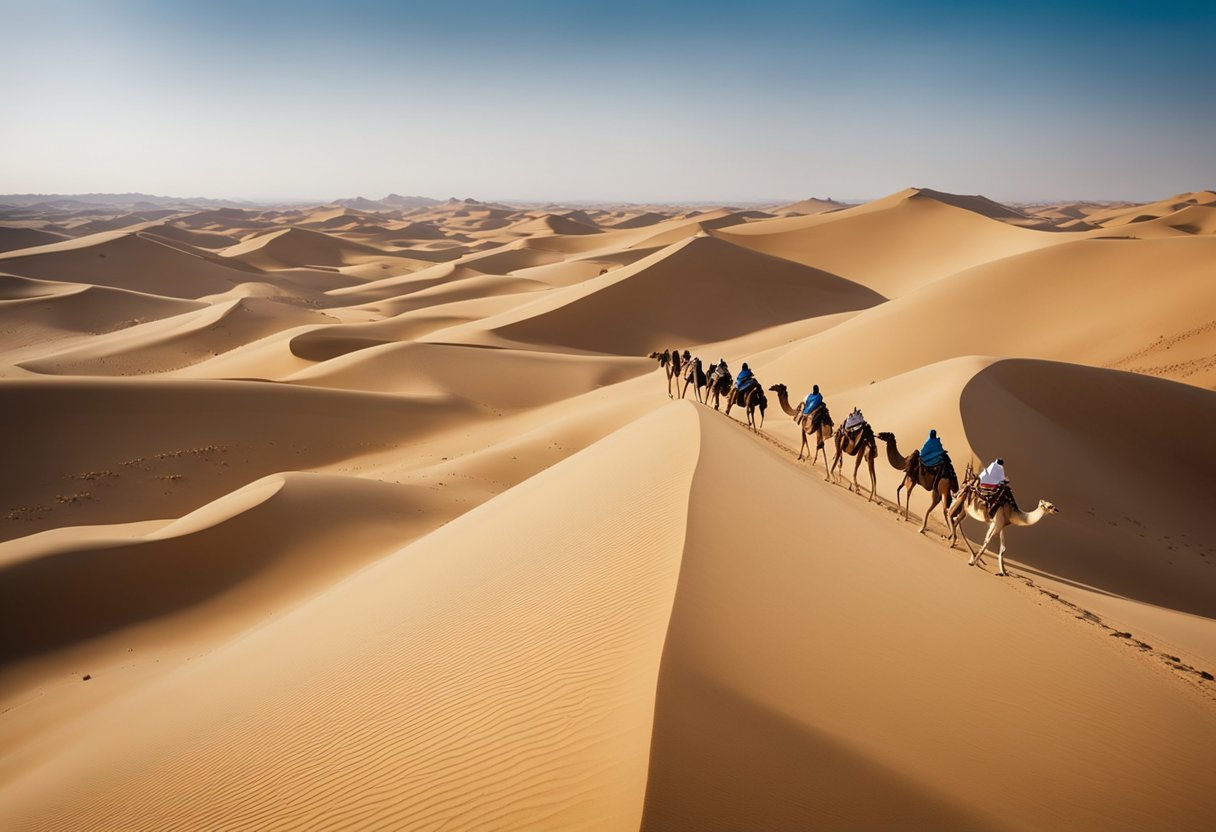
We’ve compiled some of the most common queries people have about desert lore and camel caravan tours to help you understand what to expect from such an adventure.
How much does it cost to participate in a desert lore and camel caravan tour?
The cost of joining a desert lore and camel caravan tour varies depending on factors such as the tour’s duration, the level of comfort you opt for, and the region you will be exploring. Prices can range significantly, so it’s worthwhile to research and compare various offerings.
What can I expect from a desert lore and camel caravan tour experience?
During a camel caravan tour, you can anticipate immersing yourself in the Bedouin way of life, navigating through vast desert landscapes, and learning about ancient nomadic traditions and skills essential for desert survival.
Where can I find reviews on desert lore and camel caravan expeditions?
Reviews and testimonials from previous participants can be found on travel websites and forums. These resources are invaluable to gain insights into the quality and authenticity of the tour experiences offered.
What historical significance did camel caravans hold?
Camel caravans were integral to trade across the Sahara and beyond. They facilitated the exchange of goods, culture, and knowledge between various civilisations, impacting the economic and social fabric of regions connected by these trade routes.
Which routes were traditionally taken by the camel caravans?
Traditionally, camel caravans traversed a network of well-established routes, often shifting over time, spanning the Sahara and connecting various African trade centres with the Middle East and beyond.
In what ways did the Bedouins utilise camels for their caravans?
The Bedouins skilfully utilised camels for caravans due to their remarkable adaptability to desert conditions. Camels served as a means of transportation and were revered as symbols of endurance and resilience within Bedouin culture.




